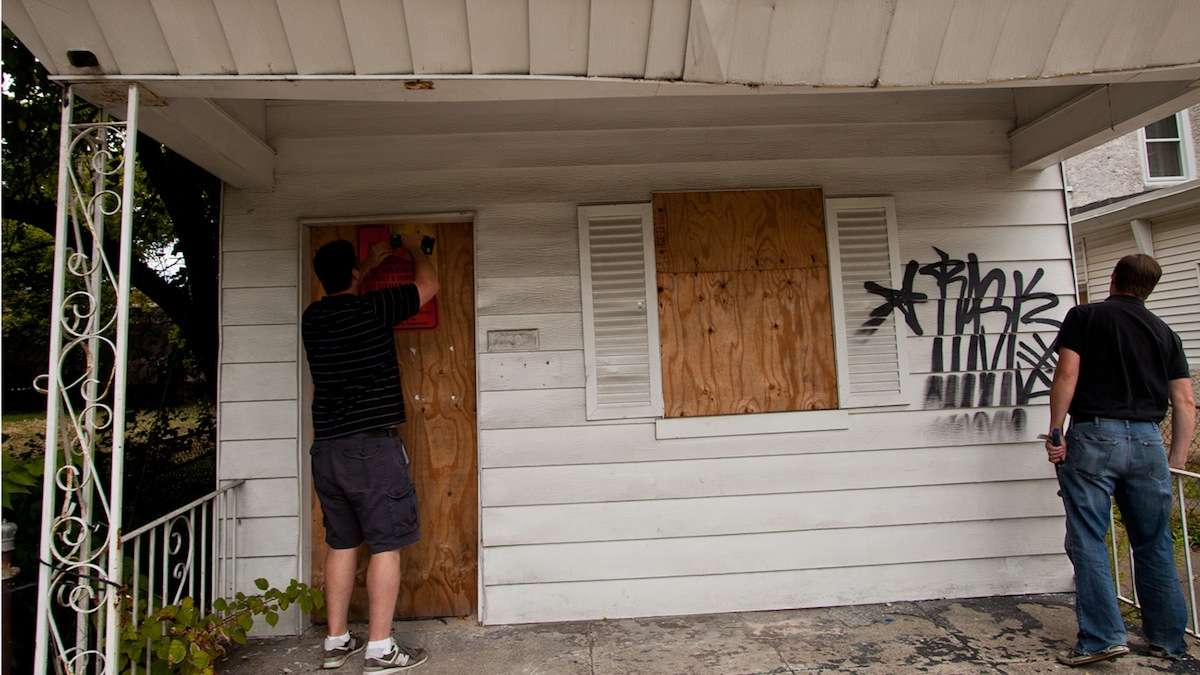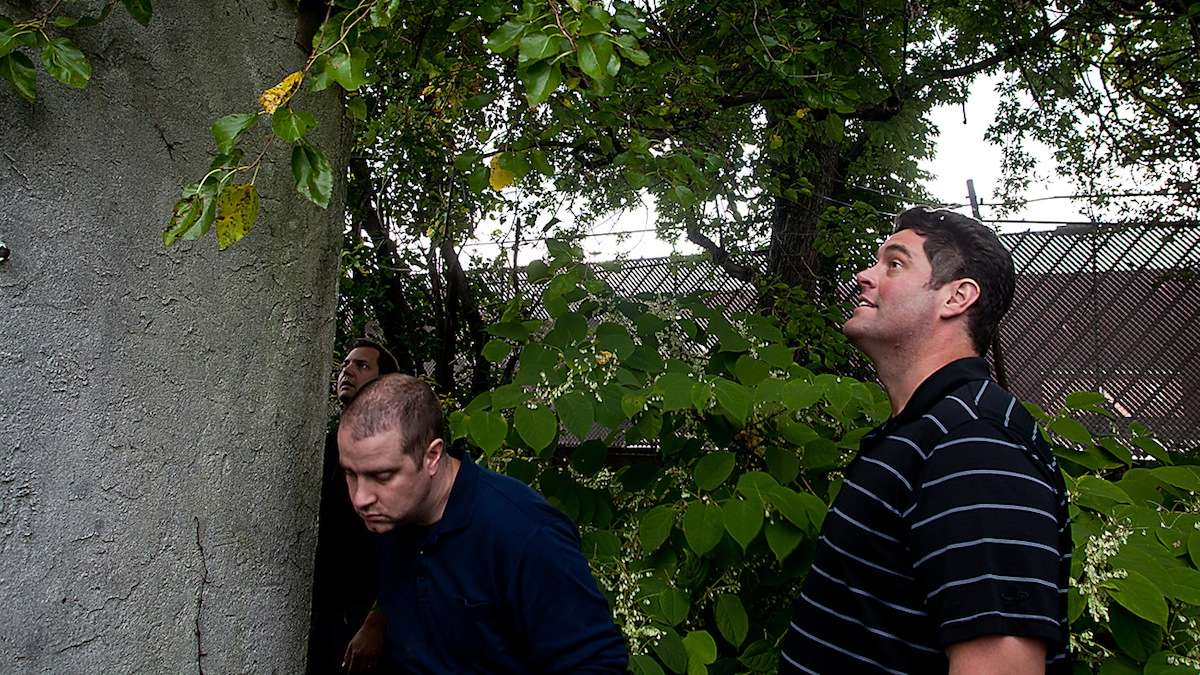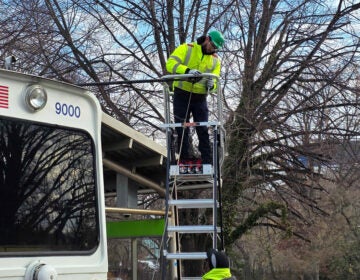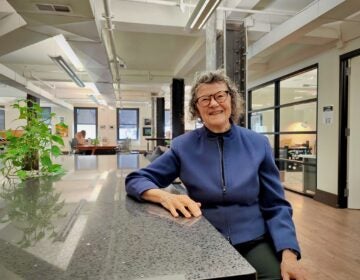Blighted property in Mt. Airy to be rehabilitated by community conservator
-

Developer Tom Moses (left) loosens boards blocking the entrance to a vacant home on Phil Ellena St. in Mt. Airy. (Brad Larrison/for NewsWorks)
-

-

-

-

-

-

-

The property on E. Phil Ellena Street in Mt. Airy is like so many others throughout the city — vacant and boarded up for years, filled with remnants from former tenants and abandoned by its owner.
“We shouldn’t have a house wasted like that,” said Felecia Smalls, who lives around the corner and walks by the house, which is located on the street’s unit block, daily. “We have to keep this neighborhood up.”
A state program could be helping make Smalls’ wish a reality as community development corporation Mt. Airy USA has gained conservatorship of the house, a move which allows the group to rehabilitate and eventually, sell or rent the property.
“We have a lot of homeowners who have been trying to fight the good fight and blight is creeping up on them,” said Anuj Gupta, executive director of MAUSA. “These [properties] are not that far gone. We can stabilize a block for the long term and put it back on an upward trajectory.”
It’s an ‘eyesore’
Jimmie Reed, owner of nearby Little Jimmie’s Bakery and Cafe, drives by the property at least five times a day. Labeling it an “eyesore,” he went to civil court with MAUSA to testify against the blight.
As a Mt. Airy resident with a business less than a block from the house, renovations have the potential to bring new customers to the neighborhood, but Reed said he also looks forward to seeing a family move in.
“This might be the dream property for someone,” he said. “When I opened my business, I wanted to help out the south side of Germantown Avenue, and to help grow this area we have to hound down on these landlords.”
A walk-through
A few days after receiving the OK from the city in late September, MAUSA entered the property for the first time with developers from AET Enterprises to see if any immediate safety issues existed.
Boards blocking the front door were loosened by drills and moved to the side to reveal an “Obama 2008” sticker, perhaps a sign of when it was last occupied.
The rooms were filled with baby equipment, mattresses, Christmas decorations, baseballs, tossed-aside picture frames, broken furniture and much more. Each room was more difficult to navigate than the last.
The property, though, was in “pretty good shape,” according to Tom Moses of AET Enterprises, who specializes in turning around once-abandoned properties.
Moses estimates the refurbishment will take six months with construction set to begin in mid-January, once the court approves the final plan for the house and budget, according to Gupta.
A negligent owner
City records indicate the house has been vacant since at least Sept. 2011, when the property was first cited by L&I for being “vacant and open to the public.”
After three notices, L&I “cleaned and sealed” it in Feb. 2012. Ten months later, L&I had to seal the property anew after the boards on the house were removed. The two actions cost the city $1,453.38.
Gupta says the property has been vacant for at least three years, however. That’s the amount of time he’s led MAUSA, whose office is less than a block away.
The listed owner of the property, KHS Equities LLC, bought the house in 2006.
“Whatever their purpose was, they were never going to do anything with it,” he said.
“KHS Equities LLC is exactly the type of property owner we don’t want in this city — a shell corporation that buys numerous properties and lets them sit vacant and blighted,” said Rebecca Swanson, communications and policy officer at L&I, adding that the company owns at least four other properties in the city, two of which have outstanding L&I violations.
How it works
“The Blighted and Abandoned Properties Conservatorship Law,” a 2009 state law (PDF) enabled MAUSA to petition to gain charge of the property by proving it was abandoned and a nuisance to the community.
The group proved neglect and abandonment fairly easily when they went to court. It can oftentimes be harder, though. The process can involve finding a family member who was bequeathed a property they don’t care to manage, or an extremely negligent individual who has to be tracked down.
Owners can show up at any point even once a community actor gains conservatorship. If they claim ownership, they are required to reimburse the investor for time, labor and money, in addition to paying up the money owed to the city.
Once the property is sold or rented out, revenue goes towards paying back liens and taxes owed to the city. After that, the investing party is paid for their labor, time and capital.
Under the law, business owners or residents within 500 feet of an abandoned property that meets certain criteria can file to be conservators as well as nonprofits within one mile of the property.
An amendment to the law from State Rep. John Taylor’s office, currently awaiting approval from the state Senate, would broaden those requirements to 2,000 feet for residents and business owners and five miles for nonprofits.
MAUSA will be holding a press conference at the property with State Rep. Cherelle Parker and L&I Commissioner Carlton Williams at 1 p.m. today to discuss the program and plans for the house.
The group expects to petition for conservatorship of at least five other properties in the area.
“It does something the city can’t do,” said Swanson, “which is pry the property out of [negligent owners’] hands.”
WHYY is your source for fact-based, in-depth journalism and information. As a nonprofit organization, we rely on financial support from readers like you. Please give today.




